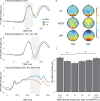Zygomaticus activation through facial neuromuscular electrical stimulation (fNMES) induces happiness perception in ambiguous facial expressions and affects neural correlates of face processing
- PMID: 38334739
- PMCID: PMC10873823
- DOI: 10.1093/scan/nsae013
Zygomaticus activation through facial neuromuscular electrical stimulation (fNMES) induces happiness perception in ambiguous facial expressions and affects neural correlates of face processing
Abstract
The role of facial feedback in facial emotion recognition remains controversial, partly due to limitations of the existing methods to manipulate the activation of facial muscles, such as voluntary posing of facial expressions or holding a pen in the mouth. These procedures are indeed limited in their control over which muscles are (de)activated when and to what degree. To overcome these limitations and investigate in a more controlled way if facial emotion recognition is modulated by one's facial muscle activity, we used computer-controlled facial neuromuscular electrical stimulation (fNMES). In a pre-registered EEG experiment, ambiguous facial expressions were categorised as happy or sad by 47 participants. In half of the trials, weak smiling was induced through fNMES delivered to the bilateral Zygomaticus Major muscle for 500 ms. The likelihood of categorising ambiguous facial expressions as happy was significantly increased with fNMES, as shown with frequentist and Bayesian linear mixed models. Further, fNMES resulted in a reduction of P1, N170 and LPP amplitudes. These findings suggest that fNMES-induced facial feedback can bias facial emotion recognition and modulate the neural correlates of face processing. We conclude that fNMES has potential as a tool for studying the effects of facial feedback.
Keywords: embodiment; event-related potentials; fNMES; face perception; facial feedback.
© The Author(s) 2024. Published by Oxford University Press.
Conflict of interest statement
The authors declared that they had no conflict of interest with respect to their authorship or the publication of this article.
Figures





References
-
- Achaibou A., Pourtois G., Schwartz S., et al. (2008). Simultaneous recording of EEG and facial muscle reactions during spontaneous emotional mimicry. Neuropsychologia, 46, 1104–13. - PubMed
-
- Alakram P., Puckree T. (2010). Effects of electrical stimulation on House-Brackmann scores in early Bell’s palsy. Physiotherapy Theory & Practice, 26, 160–6. - PubMed
-
- Ansfield M.E. (2007). Smiling when distressed: when a smile is a frown turned upside down. Personality and Social Psychology Bulletin, 33, 763–75. - PubMed
-
- Baker J., Efthimiou T., Scherer R., et al. (2023). Measurement of the N170 during facial neuromuscular electrical stimulation (fNMES). Journal of Neuroscience Methods, 393, 109877 . - PubMed

